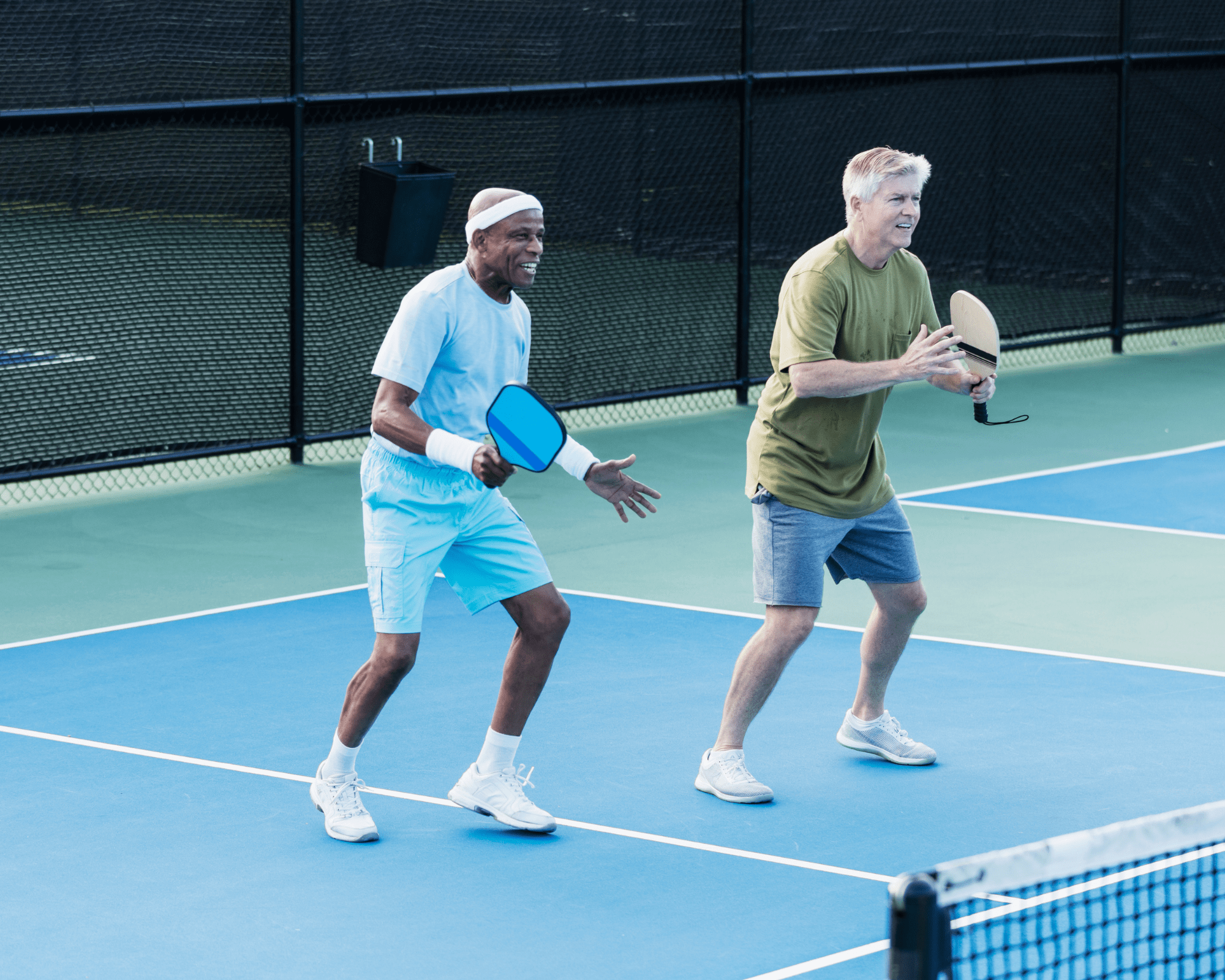Have you recently undergone knee replacement surgery and wondered: can I play pickleball after knee replacement? Whether you’re an avid pickleball player or just starting, knee replacement surgery can be a major setback.
However, with proper precautions and guidance, you can safely return to the game you love. In this article, we’ll explore what you need to consider before playing pickleball after knee or hip replacement surgery, the benefits of playing pickleball post-surgery, precautions to take while playing, and steps to ensure a successful comeback. We’ll also discuss what to avoid to prevent re-injury and tips for hitting the court after knee or hip replacements surgery.
So, let’s dive in and explore how you can safely return to pickleball after replacement surgery!
Table of Contents
ToggleFactors to Consider: Can I Play Pickleball After Knee Replacement Surgery
Before returning to the pickleball court after knee replacement surgery, remember a few essential considerations. While playing can have numerous health benefits, it’s crucial to ensure your body is ready and able to handle the game’s physical demands. Here are some things to consider:
Consult with your doctor.
First and foremost, it’s crucial to consult with your doctor before returning to any physical activity, including pickleball. Your doctor can evaluate your situation and advise whether you are ready to return. Depending on your recovery process, your doctor may recommend modifying your activity level or additional physical therapy before returning to play.
Timing of surgery
The timing of your surgery can significantly impact your ability to return to playing pickleball. If your surgery was recent, giving your body time to heal before returning to physical activity is important. Your doctor can advise you on the appropriate timing for returning to pickleball play.
The type of knee surgery
Depending on what kind of surgery you had/have, it can also impact your ability to return to the pickleball court. For example, if you had a partial knee replacement, you may be able to return sooner than if you had a full knee replacement. Your doctor can advise how your surgery will impact your ability to return to physical activity.
Physical therapy and rehabilitation
Physical therapy and rehabilitation are crucial to recovery after knee surgery. Completing your surgeon-recommended physical therapy and rehabilitation program before returning is essential. This will help ensure your knee is strong enough to handle the game’s physical demands and reduce re-injury risk.

5 Essential Steps to Safely Return to Pickleball After Major Surgery
Returning after joint replacement surgery can be challenging, but taking the appropriate steps can ensure a successful comeback. Here are some steps you can take:
Establish a realistic timeline.
Establishing a realistic timeline for your return is essential. This will depend on your recovery process and your doctor’s recommendations. Setting a realistic timeline for full recovery will help you avoid re-injury and ensure a safe return to play.
Develop a recovery plan.
A recovery plan can help you stay on track during rehab and achieve your goals. Your recovery plan should include specific steps for returning to playing, including gradually increasing your activity level, practicing good technique, and using proper equipment.
Set goals and track progress.
Setting goals and tracking your progress can help you stay motivated and focused on your recovery. Consider developing short-term and long-term goals for returning to pickleball, such as increasing your time playing or improving your technique. Tracking your progress can also help you identify areas where you may need to adjust your recovery plan.
Gradually increase activity level.
Gradually increasing your activity level is critical to a successful recovery. Start by doing low-impact exercises and progressively increase the intensity and duration of your workouts. It’s important to listen to your body and avoid pushing yourself too hard too soon. This will help prevent re-injury and ensure a safe return to playing pickleball.
Precautions to Safeguard Your Return to Pickleball After Major Surgery
Returning to pickleball after major surgery requires precautions to prevent re-injury and ensure a safe return to play. Here are some precautions to keep in mind:
Avoid sudden movements and pivoting.
Avoid sudden movements and pivoting, especially in the early stages of your recovery. These movements can strain your knee and increase the risk of re-injury. Instead, focus on slow, controlled movements and gradually increase the intensity of your activity over time.
Use proper technique and equipment.
Using proper technique and equipment can help reduce the risk of injury and improve your performance on the court. Use the appropriate shoes, knee pads, and other equipment your doctor or physical therapist recommends. Work with a coach or experienced player to improve your technique and avoid any habits that could lead to further injury afterward.
Listen to your body.
Listening to your body is essential to preventing re-injury and ensuring a safe return to play. If you experience pain or discomfort, take a break and rest. Pushing yourself too hard too soon can lead to re-injury and setbacks in your recovery.
Stay hydrated and maintain a healthy diet.
Staying hydrated and maintaining a healthy diet can also help reduce the risk of injury and improve your performance on the court. Make sure to drink plenty of water before, during, and after any physical activity. Additionally, focus on eating a balanced diet with plenty of fruits, vegetables, and lean protein to support your body’s recovery.

Benefits of Pickleball After Knee Replacement
Pickleball has numerous benefits, making it a great sport after significant surgeries. Here are some of the unique advantages:
Strengthens the Muscles:
It can strengthen the muscles surrounding the knee, such as the quadriceps and hamstrings. This increased strength can provide better support to the joint and improve knee stability, making it easier to perform daily activities.
Improves Range of Motion:
Pickleball involves movements such as twisting, pivoting, and squatting that can help improve the range of motion in your knee joint. This can help reduce stiffness and discomfort in the joint, making it easier to perform activities of daily living.
Enhances Cardiovascular Health:
Most sports are cardiovascular exercises that can improve heart health and circulation. This improved blood flow can help deliver vital nutrients and oxygen to the knee joint, promoting healing and reducing inflammation.
Increases Bone Density:
Regular exercise, such as pickleball, can help increase bone density, which can be especially beneficial for older adults. Improved bone density can help reduce the risk of fractures and osteoporosis, impacting knee health.
Low-Impact Exercise:
Pickleball is a low-impact exercise that reduces joint stress instead of high-impact activities like running and jumping. This makes it a safe choice for people recovering from joint replacement, as it can improve fitness and mobility without straining the knee.
Improved Balance and Coordination:
Pickleball requires quick reflexes, hand-eye coordination, and balance, improving with consistent play. These benefits can be highly significant for older adults and baby boomers, as balance and coordination tend to decline with age.
Weight Management:
Did you know that pickleball can help you lose weight by burning calories? It can help with weight management, providing moderate physical activity that can burn calories and improve metabolism. This makes it an excellent choice for those looking to maintain or lose weight after knee replacement surgeries.

Can I play Pickleball After Hip Replacement?
Yes, you can play pickleball after hip replacement surgery. However, checking with your doctor to determine if you are ready to resume physical activity is essential. Your doctor will evaluate your overall health, the extent of your surgery, and your recovery progress to determine if it is safe for you to start playing pickleball again.
Assuming your doctor has given you clearance to play, there are some precautions you should take. Like knee replacement surgery, playing pickleball after hip replacement surgery involves low-impact movements that can help improve your overall health and fitness.
However, avoiding activities that put too much stress on your hip joint, such as running, jumping, and sudden twisting movements, is crucial. Instead, focus on activities that involve slower movements and controlled motions, such as walking, biking, and playing pickleball.
To play pickleball after hip replacement surgery, it is essential to follow some general guidelines to minimize the patient’s risk of injury:
Warm up and stretch before playing
Wear appropriate footwear and supportive braces if necessary
Start slowly and gradually increase your level of activity
Take frequent breaks to avoid fatigue
Avoid activities that cause pain or discomfort
Consult with your doctor if you experience any new or unusual pain
By taking these simple rules and precautions, you can safely and enjoyably play pickleball after hip replacement surgery and enjoy the numerous benefits of this popular sport.
Wrapping Up
Playing pickleball after major surgery, such as knee or hip replacement, can significantly improve your overall health and fitness. However, taking proper precautions and following your doctor’s recommendations is essential to ensure a safe and successful recovery.
Remember to start slowly, warm up before playing, wear appropriate footwear and supportive braces, and avoid activities that cause pain or discomfort. By taking these steps, you can safely return to playing pickleball and enjoy this exciting sport’s many physical and mental benefits

